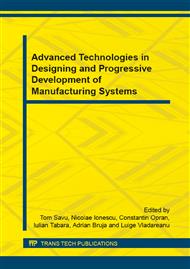p.521
p.527
p.533
p.539
p.545
p.551
p.557
p.563
p.571
Theoretical and Experimental Cladding Technological Process of Spare Mechanical Engineering
Abstract:
The paper presents the process of cladding surfaces required strong corrosion of parts in the chemical, petrochemical and engineering industry. The phenomenon of the factors that influence the dilution that occurs between the filler material and the base material and the technological processes possible to achieve efficient plating. Following technical and economic analysis establishes that process arc welding argon environment is a process that can be used optimally to plating. It presents experimental results obtained after plating surfaces of parts of the petrochemical industry, the functional characteristics of materials resulting torque in all three major areas (base material, heat affected zone and weld material), structural analysis and possible defects that may occur after the plating process.
Info:
Periodical:
Pages:
545-550
Citation:
Online since:
May 2015
Keywords:
Price:
Сopyright:
© 2015 Trans Tech Publications Ltd. All Rights Reserved
Share:
Citation:


